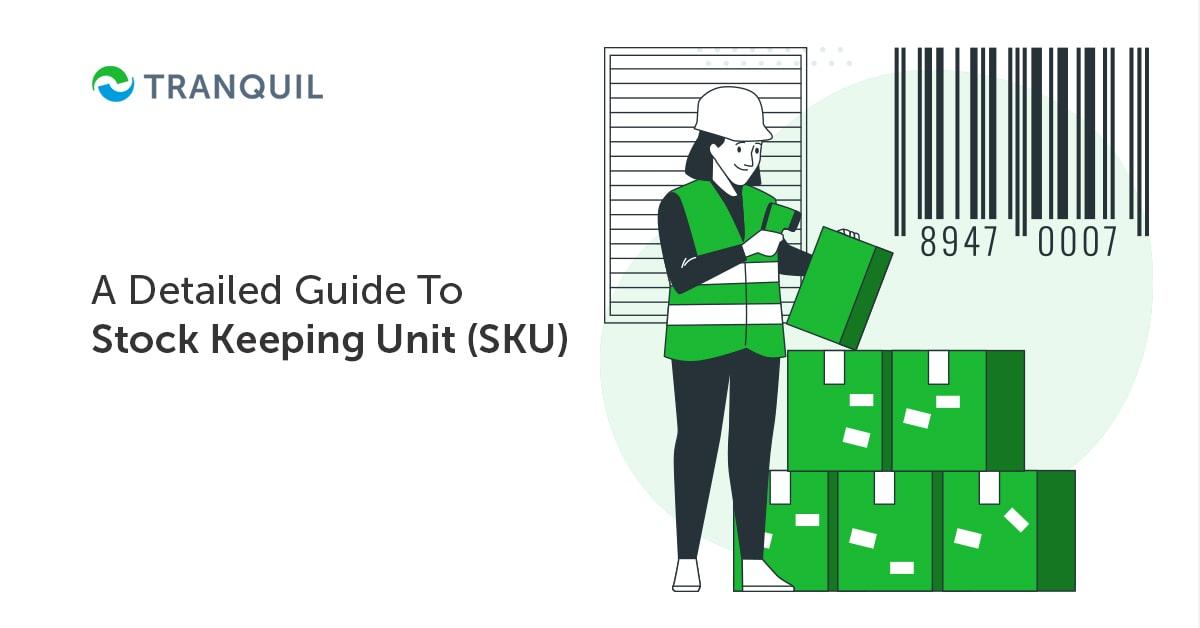
A Detailed Guide To Stock Keeping Unit (SKU)
Inventory is one of the most important assets for any business; after all, it is when a business sells goods that it earns revenue.
There are dozens of aspects involved in inventory management; to ensure efficiency, the relevant persons in charge need to be diligent and ensure that, stock can be easily identified, there is no dead stock, under or over-stocking, and so on.
An SKU number is one element that helps in effective inventory management.
What is an SKU?
An SKU or stock keeping unit is a unique alphanumeric code or number that is given to a specific product to make it easy to track and manage.
It is an identifier allocated to individual products that simplifies the task of maintaining records.
You could say that SKUs are the fundamental building blocks of inventory management, as they help to identify products, check stock levels, and determine inventory turnover, and profitability, among other things.
ALSO READ: Why is Cycle Stock Important for Your Business?
SKU and UPC or Barcodes

An SKU can consist of any series of numbers or alphanumeric codes that you prefer, and they are unique, with every retailer assigning SKUs according to their in-house system.
This means that you could buy the same brand of toothpaste of the same size (say 120 grams) from two stores, and each one will have different SKUs.
An SKU can be any series of numbers or a combination of alphabets and numbers as decided internally, hence there could be several variants of SKUs for the same product.
Barcodes are nothing but versions of the UPC that can be scanned and read by machines.
This means the 120-gram toothpaste of Brand X will have only 1 UPC or barcode, but multiple SKUs.
There is no specific rule for creating an SKU; you just have to ensure that your employees are familiar with the system.
SKUs are simple and do not necessitate machines to understand or break them down.
ALSO READ: Common Inventory Management Problems and Solutions
How Are SKUs Created?

We have already seen that an SKU code is normally made up of numbers, alphabets, or a combination of both.
These alphabets and numbers provide product details like brand, model, colour, size, and so on.
While there is no set rule for creating an SKU, certain best practices have to be remembered:
- Every stock keeping unit code must be unique, and not reused
- Long SKUs may become confusing; it is good to keep it as short as possible
- Special characters like *, #, & and so on, as well as spaces, should not be used as they are vague and can cause confusion.
- Avoid using letters like O and I by themselves as they can be mistaken for numbers 0 and 1.
Example of an SKU Code Generator
So how is an SKU code created?
Let’s suppose a retailer sells Tag Heuer watches in the Carrera style; for this watch with leather strap and blue dial, the SKU may look something like this: TH-CRA-LTR-BLU.
The dashes are used to separate the different items.
Here, TH stands for the brand Tag Heuer, CRA for the model name Carrera, LTR for leather, and last BLU for blue.
This is a simple, easily understood code for store employees.
For products sold in different sizes, the size number is usually appended at the end.
For example, let us say we have to create an SKU for a pair of Levi’s Jeans, 501 models, light blue, in size 34.
It could be something like this:
LEV-501-LBL-34.
ALSO READ: Common Inventory Management Mistakes to Avoid
The Importance of SKUs

Stock keeping units are essential for proper inventory management, and are used by e-commerce sites, brick-and-mortar stores, warehouses, and product fulfilment centres.
Regardless of whether you are an established business or are just starting one, SKU numbers are helpful in managing inventory.
They help in creating a streamlined checkout system, deliver essential data that enables informed purchase of goods, and help minimize human errors, thereby boosting profitability.
Many key business areas can be planned and managed better if you implement a well-thought-out SKU system.
SKUs serve certain key purposes, like:
- Product identification
- Inventory tracking
- Identifying product availability and its quantity
- Reconciliation of product inventory levels
- Detecting inventory shrinkage
- Establishing the most profitable products
- Setting product reorder points
- Saves time with instant product identification
ALSO READ: What is Negative Inventory and How Can you Prevent it?
Let us look at the most important points in detail:
1. Enhanced Shopping Experience
Thanks to SKU numbers, you can organize your store better, helping both staff and customers to find products easily.
You can track products according to brand, type, collection, etc – this helps to organize and find products easily not only on the sales floor but in warehouses too.
You can also offer a user-friendly and attractive shopping experience to your customers with enhanced merchandising – and this means more sales.
You could easily get confused about where your products are displayed without SKU codes; this means annoyed shoppers, hassled employees, and a loss of sales.
2. Points out Small Differences
Going by the example of the watch, let us suppose that the same watch model is also sold with a steel strap, and white, grey, and cream dials.
In that case, the SKUs are likely to look like these:
- TH-CRA-LTR-BLU
- TH-CRA-LTR-WHT
- TH-CRA-STL-CRM
- TH-CRA-LTR-CRM
- TH-CRA-STL-BLU
ALSO READ: What is Pipeline Inventory and Decoupling Inventory?
3. Improved Customer Service
With a streamlined SKU system, you can ensure a smooth and hassle-free checkout system.
When you are able to use SKUs to track products in a POS system, it renders error-free inventory and pricing.
As you check out customers, the till rings up the correct pricing, and decreases the quantity on hand to reflect the quantity sold.
Also, with an SKU search in your point-of-sale system, you can easily check the stock status if a customer is unable to find a specific item.
4. Helps in Cross-Selling
For online retailers, having proper SKUs can help in cross-selling.
For example, when a customer adds a product to their cart, the site can recommend complementary products, based on its SKU.
Let’s say a customer adds a mobile phone to their cart.
The online site will immediately suggest items like screen guard, adapter, earphones, phone covers, and even protection plans.
ALSO READ: What is Backordering?
5. Inventory Management and Profitability
Retailers lose a lot of inventory to theft, damage, and errors in inventory management, causing them to incur huge losses every year.
Theft can be controlled or detected by installing security systems.
But the main loss usually occurs through administrative and data entry mistakes; these tend to pile up, impacting your bottom line negatively.
A properly implemented SKU system can help prevent loss of profit in the following ways
- Organizing the warehouse and tracking excess stock for order in the future
- Checking and managing inventory shipments to eliminate shortages in shipment
- Using supplier codes to extract inventory quantity for a single vendor to check inventory on the spot
- Draw a sales report for one item type code over a specific period
- Pulling up a report of restock orders for a specific department in a store.
ALSO READ: What is Inventory Cycle Counting and What are its Benefits?
Application of SKUs

Let’s consider this real-life scenario.
A small grocery store sells 10 brands of jam.
A customer walks in and asks the owner for brand Z jam, which the owner recognizes, and says that they do sell the brand.
The owner takes the customer to the area where jam bottles are displayed, only to realize that the particular brand is sold out.
Now the owner is embarrassed and has to apologize to the customer, who in turn gets annoyed, and leaves without buying.
The owner then thinks of assigning unique codes for each product so that a cursory search in the system can reveal whether the product is available, and if yes, how many units are available, rather than do a manual search every time.
Now that SKUs are there, all the owner has to do is check the computer to see the availability, handling the situation much more efficiently.
ALSO READ: Physical Stock Verification and Its Advantages
How are SKUs Used in Ecommerce?

Stock keeping units help in tracking both inbound and outbound inventory.
It is also immensely helpful when you have to work with a third-party fulfilment service provider.
The logistics provider is likely to want to know how many different SKUs are there in your inventory, as it will help them in determining your warehousing and storage requirements, and also the level of complexity of your orders.
Usually, third-party logistics providers store unique SKUs in separate bins or shelves so that the picking process can be optimized.
This also helps to make the packing process more efficient.
The third-party logistics provider is likely to offer an all-inclusive inventory management solution that includes the below-mentioned SKU-based services:
- Inventory syncing with automatic extraction of SKUs from your E-commerce site
- Display of inventory as per SKUs in real time
- Configuring reorder levels for every SKU depending on the stock level at which you want to place new orders
- Bundling varied SKUs for special offers
- Combining the same product across E-commerce platforms
- Special assembly and packaging of SKUs prior to shipping
This means that third-party logistics providers keep track of inventory and offer tailored and detailed analytics and services for your E-commerce business utilizing your SKUs.
ALSO READ: Ways to Improve the Procurement Process
Calculating the Number of SKUs in Inventory

You can calculate how many SKUs you have in your inventory by taking into account all the product variations in your inventory.
This means differences in price, size, colours, models, and so on. How many product variations do you have, and how many SKUs will be there in your online store?
Continuing with the example of the watch, let us say you have two models of the same brand, Carrera and Formula 1.
They come in steel straps, leather straps, rose-gold metal straps, and combined steel and yellow metal straps.
Leather straps come in black, blue, red, green, brown, and maroon. Dials are white, grey, cream, blue, black, and green.
That means 2 models, 4 types of straps, 6 colours in leather, and 6 colours in dials.
So, the number of product variations is 2 x 4 x 6 x 6. That means 288 variations.
This translates to 288 SKUs in your online store.
ALSO READ: Benefits of E-commerce and ERP Integration
Conclusion
SKUs may seem overwhelming and confusing at first, but they are not; in fact, they are a critical part of inventory management and the successful customer order fulfilment process.
Generating each SKU however can be a laborious and time-consuming task.
With a robust ERP system like Tranquil, which has a feature-packed inventory management module, all of this can be automated and streamlined, increasing efficiency, and reducing effort, time, and cost in the long run. To understand how Tranquil ERP can help your business, schedule a demo at your convenient time, and we will be happy to show you.



